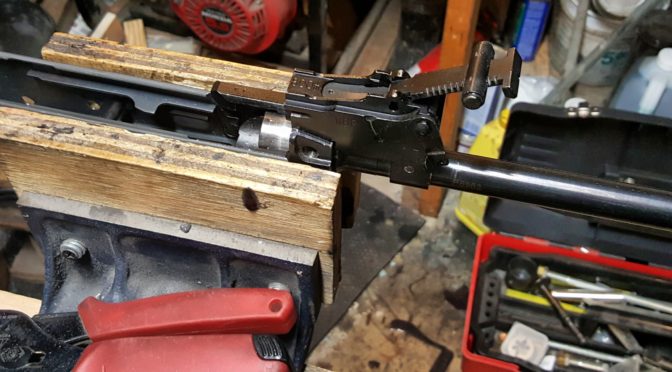For years I used my 20 ton press to remove and install barrels on AK rifles and then somone, Gunplumber maybe, told me to try using an air riveter instead. You know what, it surprisingly works well and now I only use my press on the removal of really stubborn barrels.
I am going to throw two terms around in this post that I need to explain. Air hammers and air riveters are remarkably similar – a pneumatic (air powered) pistol is going down a bore and slamming into the end of the unit where a tool is attached. Thus they are delivered from the hundreds to almost three thousand blows per minute (BPM). What usually, but not always, differentiates the two is the degree of control you have with the trigger and an integral air regulator to adjust the BPM and how hard the blows are. If you see a tool with virtually no controls, it is likely an air hammer. However, as you will read here, there are air hammers that do overlap with air riveters.
With air riveters, the main thing you get is a variable flow trigger, sometimes called a “tickle trigger” and usually a built in air regulator. This allows you to really dial in the speed and strength of the blows. When guys gush about how well they can control a big riveter, pay close attention because they aren’t kidding. When you are building an airplane you need precision and you sure don’t want the riveter to slip and mar the aluminum. Traditionally with air hammers we think about driving apart exhaust pipes, cutting open barrels and what not. With air riveters, think of airplanes,
Okay – enough background – let’s talk about how to size these things – riveters are are sized based on the stroke length of the piston and an arcane naming scheme like “2X”, “3X” and “4X”. Each has a piston about one inch longer than the previous model and the longer the piston, the harder it hits and the bigger rivet you can drive. Think of the piston in a car – diameter and stroke set the stage for more power.
For example Aircraft Tool Supply sells all kinds of tools for folks who build airplanes and have decent riveters – I have one of their ATS-3X units and it has held up great. At any rate, here are their tool ratings for example:

Note how the stroke is increasing from their base 200B unit through the 4x. When you get to the 5x and 7x, both the stroke and bore size increase. The capacity stated is for aluminum rivets so for steel rivets go two sizes up was a rule I was once told.
Most rivets you encounter around firearms will be steel and between 5/32″ to 3/16″. I was told not to go smaller than 3X and have no regret with doing AK trigger guards but I did wind up with two units because I wanted to more powerful unit for barrels and barrel pins. By the way, I was told not to go too small or all the hammer blows would risk work hardening the rivets.
Historically, I have mainly used this riveter for the trigger guard and an occasional barrel pin. For most of my heavy work such as barrel pins and barrels, I use an Ingersoll-Rand (IR) model 117 air hammer. Now here’s the interesting thing – most air hammers, especially cheap imports, do not have variable triggers – they tend to be on or off. Like riveters, the IR 117 has a variable trigger and a built in regulator. With piston stroke of 3.5″, and an 22/26″ bore it makes the 117 a tad bigger than the 4X riveter from ATS so all things being equal, the IR 117 will hit harder.
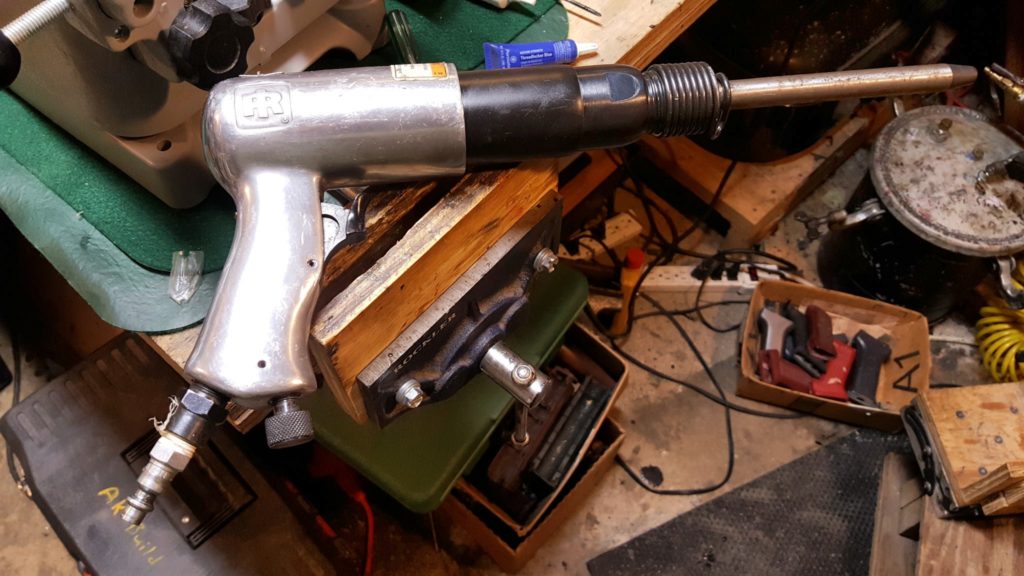
I know Harbor Freight has an air riveter now (they didn’t when I bought mine) but have zero experience with it and also not so good experiences with their air hammers not lasting.
Even Amazon now has a wide selection of 3x and 4x riveters. Click here to see them in a new tab. Amazon’s searches return pop riveters and all kinds of stuff – you want the solid rivet guns to be clear.
A big requirement for this work is control – you need a variable trigger so you can get just a few blows all the way up to continuous. A regulatory allows you to adjust how hard the unit hits. Some past import air hammers I have used seemed to have triggers that were either wide open, or completely unpredictable. If you have one that is this way, don’t try working on a firearm that you care about.
Both the ATS and IR units were recommended to me and I both do a great job. Note, there are bigger riveters and air hammers out there but you will notice that the tool shank goes from the very common 0.401″ to a larger diameter such as 0.498.
At any rate, let’s get back to barrels. Modern AK barrels are what is known as an interference fit with the barrel being pressed into the front trunnion and locked in place by a cross pin. In general a 12 ton press will do the job reliably but it takes a while to get the jigs set up and parts ready to go. A 4X riveter will usually do the job also but with way less set up time. I say usually because once in a while you run into pins or barrels that just do not want to come out and that’s when a big press is the way to go.
Practice First
Let me give you one piece of honest advice – if you go this route, practice before you beat the snot out of your parts. Air riveters and hammers want to move around on you and you need to know how to control them.
Removing the Barrel Pin
Now you may wonder why I went the pneumatic route vs. sticking with my press. The answer is real simple – when I am taking stuff apart, I don’t want to take a ton of time. I can use the 117 to pop out the barrel pin with either a drift pin or a tapered pin in seconds with very little set up. I usually just put the trunnion and barrel assembly on bench block with a hole for the pin to enter as I drive it out from the other side – I drive from the operating side (right when viewed from the top) towards the non-operating side (the left side).
If you are using a tapered pin driver, get the pin started and stop before the tool will hurt the trunnion. You can drive it out the rest of the way fairly easily with a drift punch and a big hammer. If you have drift punches for your air tool, just pick one slightly smaller than the hole and drive the pin out.
These days I keep parts in a magnetic tray to avoid losing them and that’s where I stick the barrel pin. If you ever lose or damage the pin, get a 7mm drill bit and cut off the shank to create the length you need. I used to keep 7mm drill rod somewhere – I’m not really sure where it is now.
Backing Out the Barrel
Driving the barrel off the trunnion is pretty easy but you do need to make a tool that fits in the trunnion and has a brass “head” to drive the barrel out without damaging the chamber end – DO NOT USE STEEL – it needs to be a softer metal and brass does a good job.
My backout tool is a 6″ long 1/2″ bolt with a brass nut on the end with a ground down steel backing nut behind it:
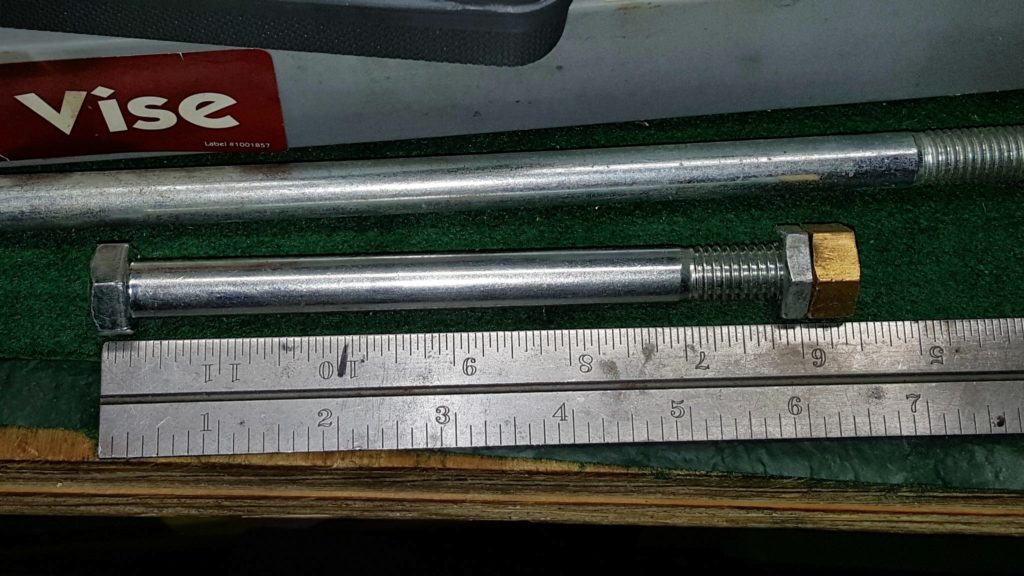
Why 6″ long? Because that is what I had in my box. Shorter would be more controllable. I actually have a long 12″ unit I use if I need to back a barrel out of a trunnion that is in the receiver.
Here’s a photo of the ground down steel backing nut and the brass nut that sits on the chamber end and applies the actual blows to drive it out.
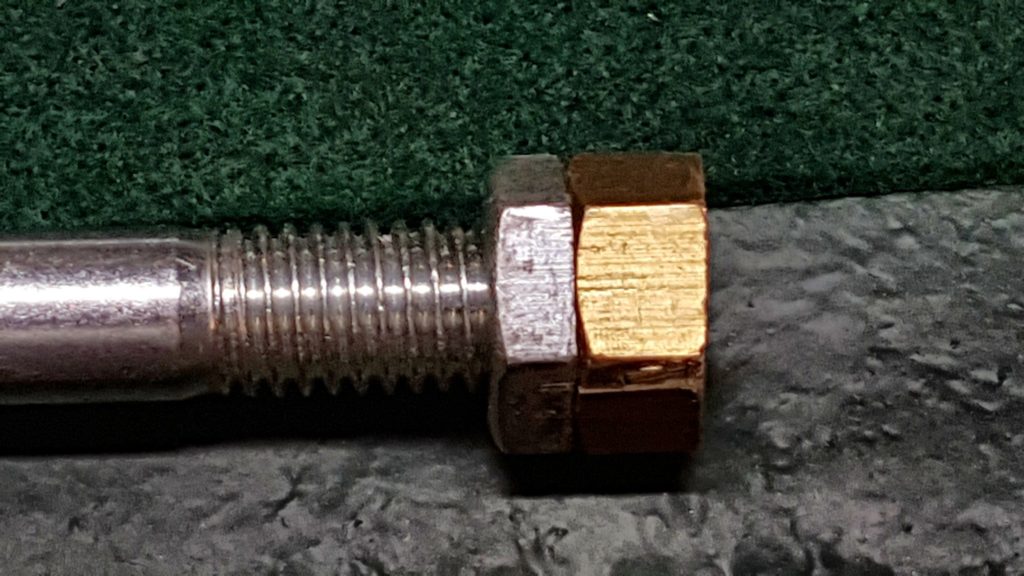
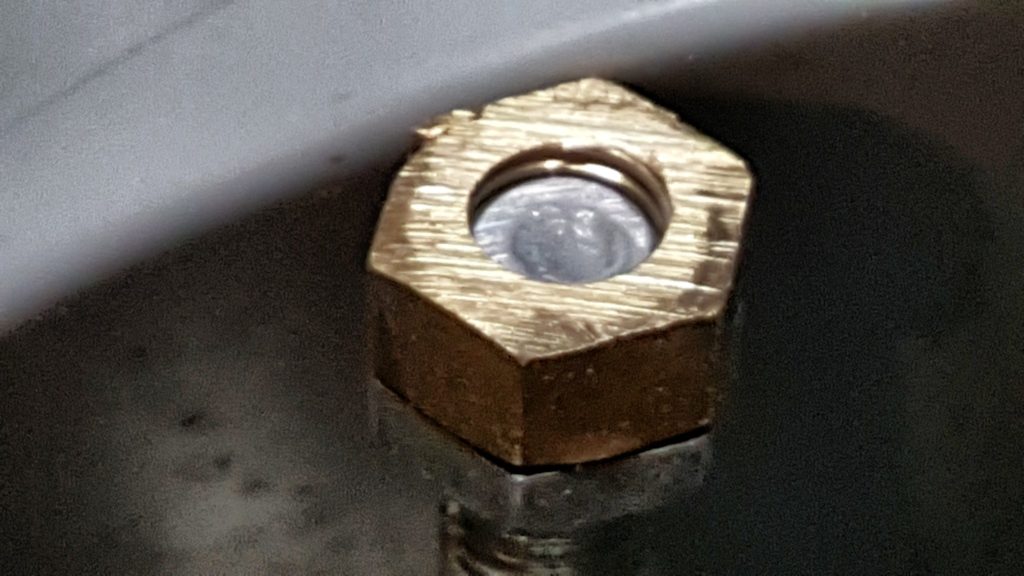
You definitely need the steel backing but or the brass will deform and come off the threads. You can also see how the brass extends in front of the bolt – I always check to make sure I have about an 1/8th inch or so of brass before I use it. This is basically a shorter version of my barrel back out tool (click here for the post about that from way back when).
Now to deliver the blows on the business end of my IR 117 is a 7″ brass peening tool that ATS sells directly. I bought a 3″ unit but it will not fit in the wire retainer of my 117. They also have a 5″ model that I bet would work fine.
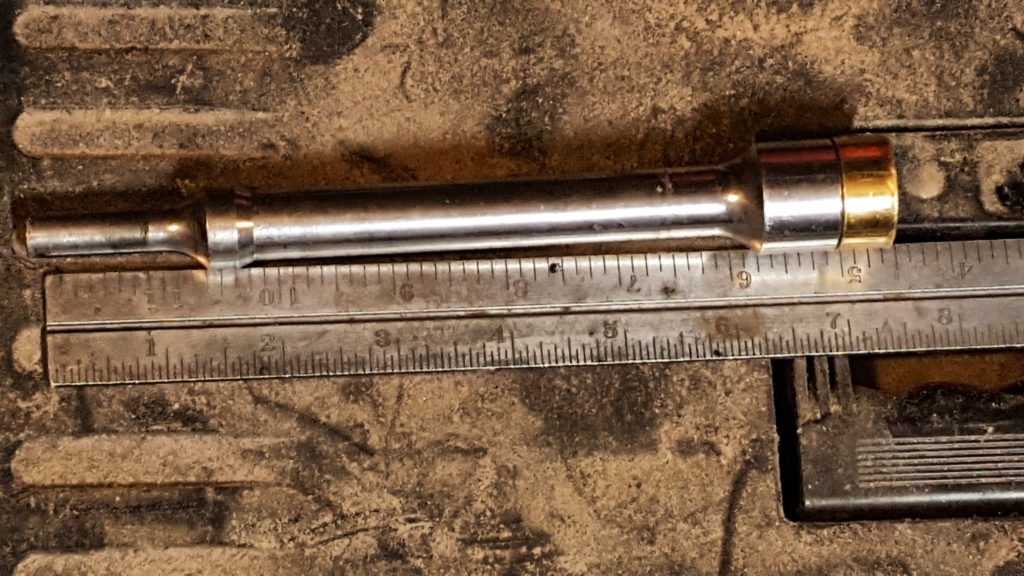
So, I mount the trunnion in my wood jawed vise to not tear it up, insert the backout tool and then use the 117 to apply the blows. I will hold the bolt with one hand and use the 117 with the other. Do NOT put your hand where the bolt and peening hammer come together or you will pinch the hell out of it. I did that once years ago and it taught me a lesson complete with a blood blister as a reminder.
So I do a bit and check – I do not try to do it all at once. By looking int he barrel pin hole, you should see it slowly backing out. In general, the last bit of removing the barrel I do with a big ball pein hammer to make sure the barrel assembly either is pulled out the last bit by me or land in some form of box or cushion vs. the hard floor.
That’s it! The barrel is out.
Installing the Barrel
To install a barrel, I first install an old slant brake that I ground flat to protect the threads. I have not used a muzzle nut because they do not seem to offer much protection to the front of the muzzle – they are mainly designed to protect the threads. With the ground down slant brake, there is a plenty of material in front of the muzzle to protect it. 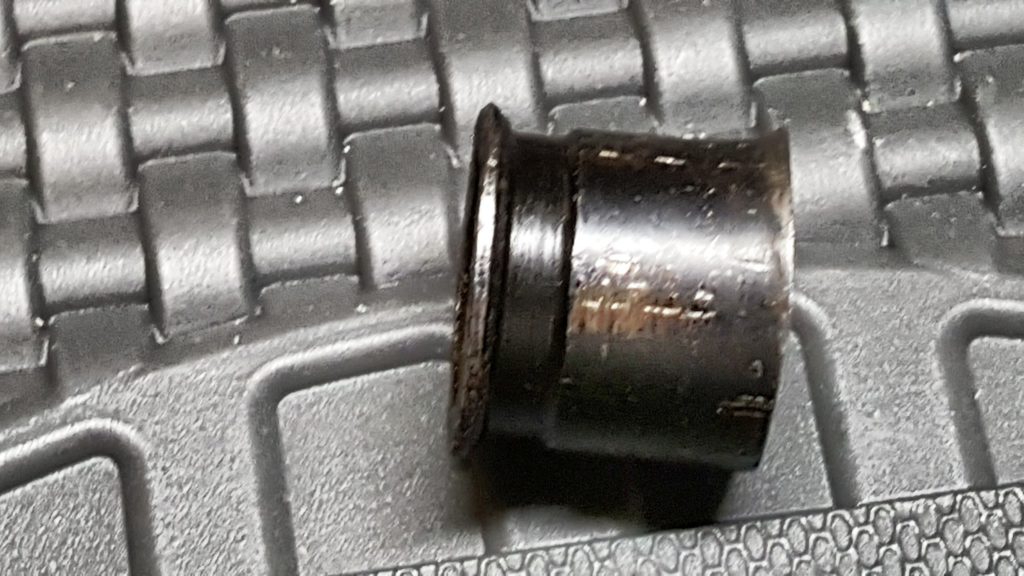
You can see how it has mushroomed over time but that’s fine. I’ve used it a ton and if I ever have a problem, I’ll chuck it and make another.
My best guess is that it came out of a Romanian G kit years ago. I have a bunch of oddball parts like this that got replaced by US parts for the sake of 922r compliance.
I thread the converted brake / muzzle protector all the way back on the barrel to engage all the threads possible and back it right against the front sight block (FSB). The idea is that you want the threads to take the impact and not the muzzle.
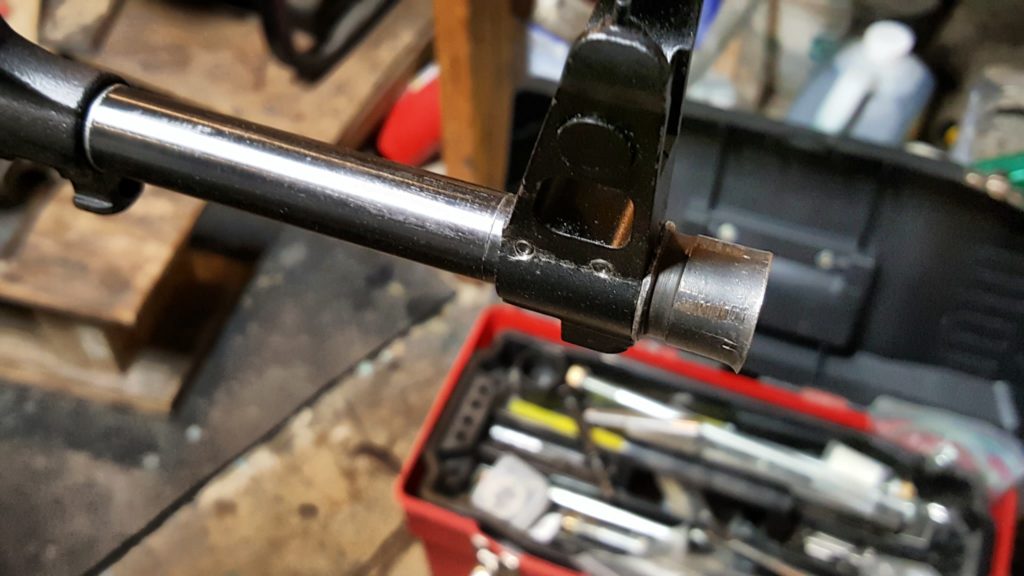
To start the installation, I push the barrel assembly into the trunnion and tap it with a big ball pein hammer. I keep sighting down the rear sight block (RSB) making sure it is true. At the point, you can use a rubber mallet or other non-marring mallet to tap the RSB and angle the barrel slightly one way or the other to course correct. It is really, really important to get the alignment right at the start. You will not be able to adjust it once you get very far in. If it turns out you have alignment problem later, I would recommend driving the barrel assembly out and starting over.
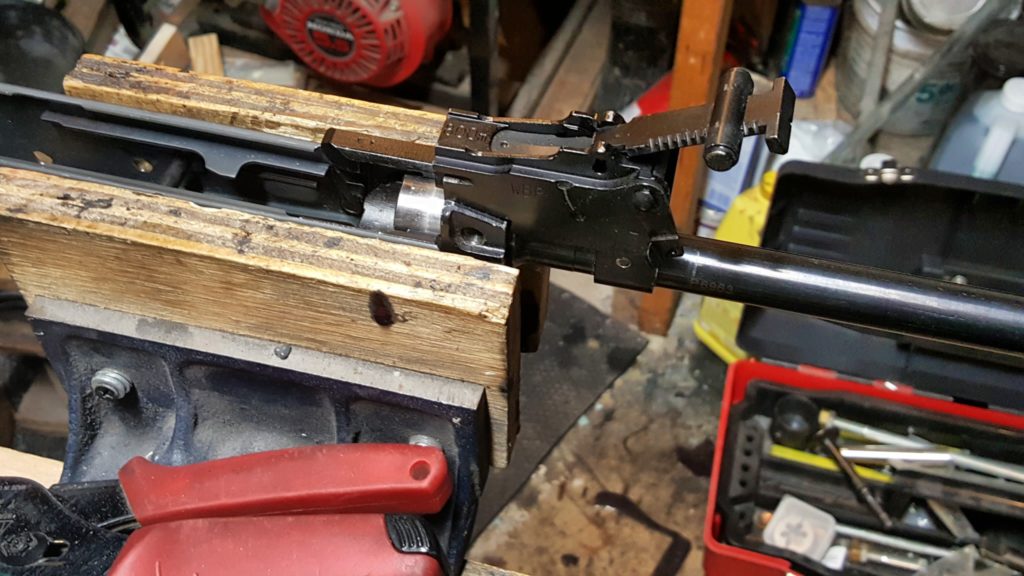
To do the actual driving, I use the IR 117 with the brass peening hammer attachment. I put the brass hammer face right on the converted slant brake and drive it in. I keep checking the barrel pin hole to make sure I stop just short of the final location and that it is aligned. If the surfaces are not aligned, I would drive the barrel back out and start over. In this next photo, you can see I stopped just short of where I need to be.
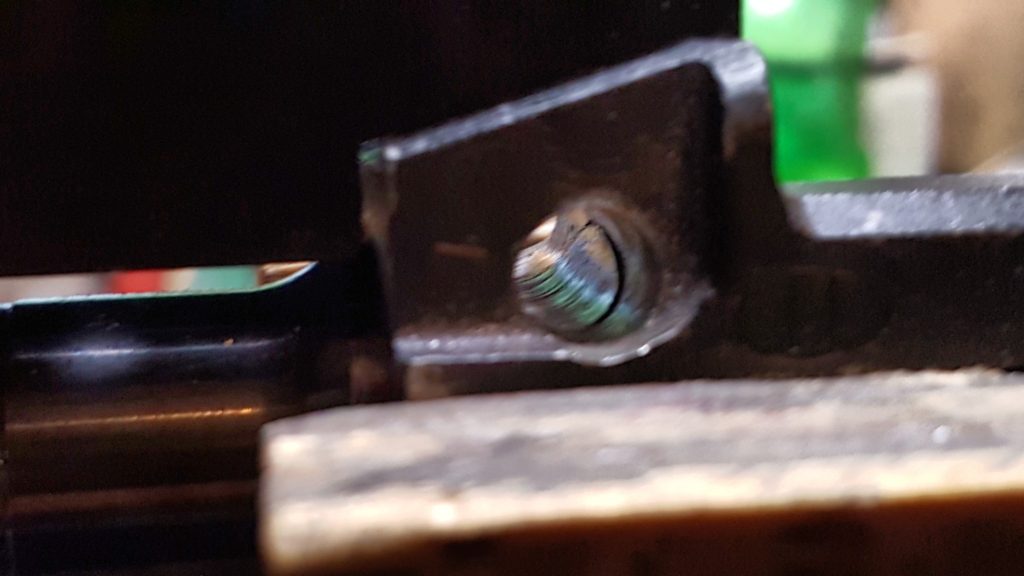
Now this particular kit was a headspaced Polish WBP kit and I had checked headspace before I removed the barrel. If I needed to set the headspace, I would start checking it somewhere around here.
At this point, I drive the barrel in the rest of the way by tapping the end with a big ballpein hammer – or any BFH will do 🙂 It really doesn’t take a ton of energy. You want to tap and test over and over. Don’t get impatient and try and drive it in all at once or you risk overshooting where you want to be. If you do overshoot, it’s going to take some time and you need to make that longer barrel backout tool and either use your press or your air tool (I’d use my IR 117) and push it back out just enough to then fine tune the location.
Do not use headspace gauges as barrel stops. You may know this but just in case you don’t – gauges are precision instruments and you only install them to test the headspace and *not* as a way to stop travel. I’ve heard of guys doing that and, for a change, I wasn’t one of them 🙂
Once the channel is clear and you have one nice continous path from one side of the trunnion to the other it is time to reinstall the pin.
Installing the barrel pin
With I do is start the pin with a big ball pein hammer and then drive it in the rest of the way with an old rivet set that I use just for this purpose. Years ago I bought a ton of used 0.401 shank rivet sets and rivet tools off eBay for a very reasonable price. I use one that covers the pin nicely and drive it right in and let me tell you, it goes in fast. You can stop short and drive it in the test of the way by hand if you want. I tend to just drive it right into place with the air tool.
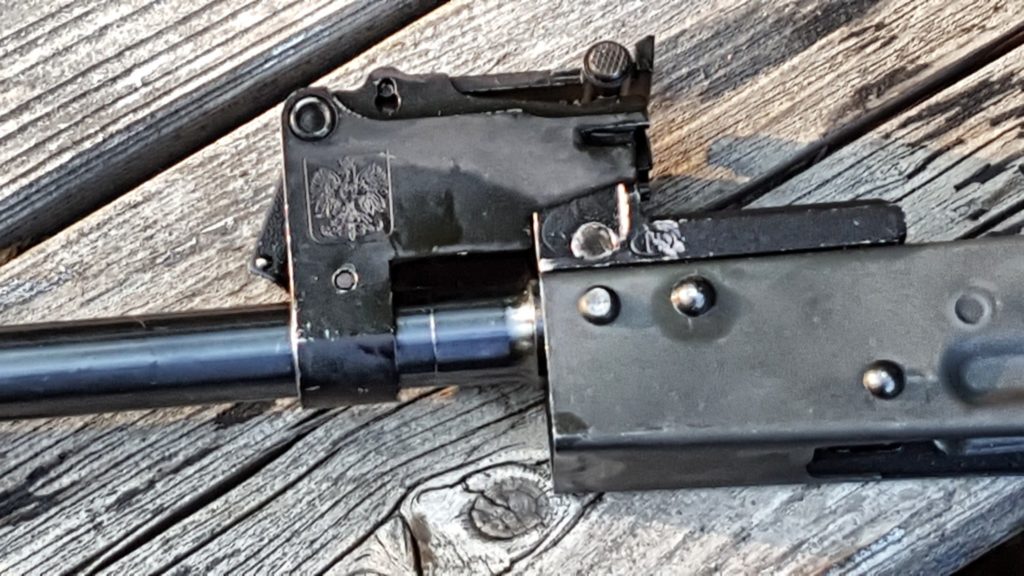
By the way, I’ve accumulated a number of rivet tools and bucking bars over the years. Here’s a quicksnap shot of my toolbox:
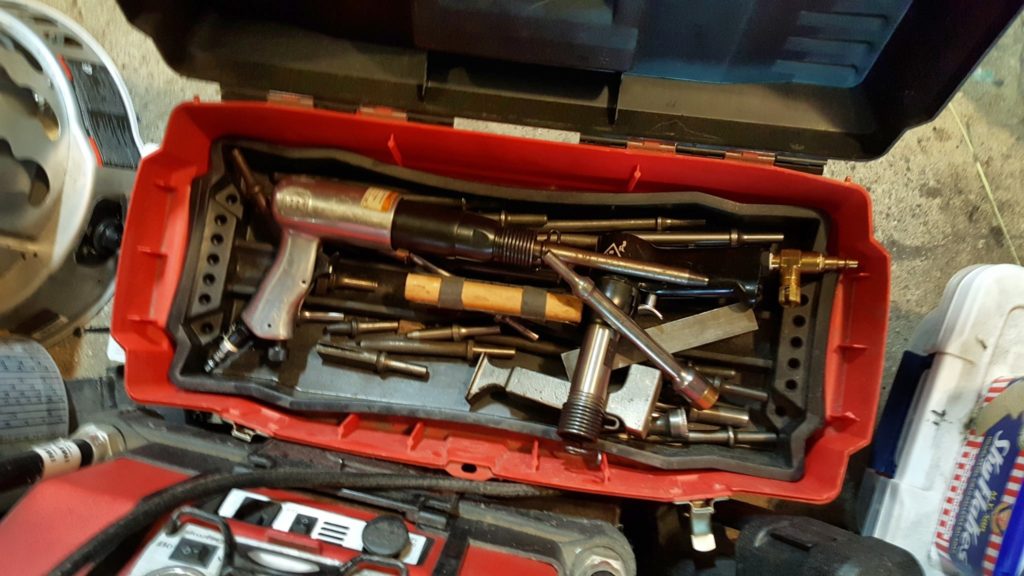
That’s it – done. I hope this helps you out!
By the way, here are used rivet tools currently on eBay. Be sure the shank size matches your air hammer or air riveter (all of mine are 0.401″ for example).
| Palmetto State Armory (PSA) has a stunning array of Kalashnikov firearms now. AK-47s, AK74s, 100 series, rifles, pistols … it’s impressive. Click here to go to their main AK menu. |
If you find this post useful, please share the link on Facebook, with your friends, etc. Your support is much appreciated and if you have any feedback, please email me at in**@*********ps.com. Please note that for links to other websites, we are only paid if there is an affiliate program such as Avantlink, Impact, Amazon and eBay and only if you purchase something. If you’d like to directly contribute towards our continued reporting, please visit our funding page.
